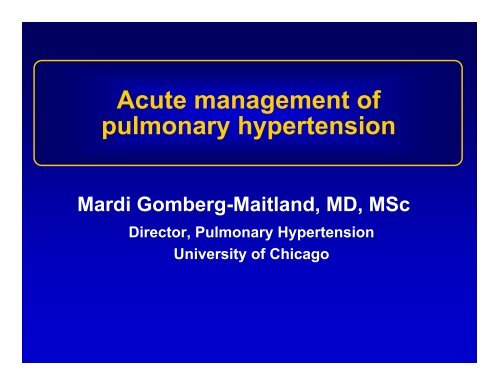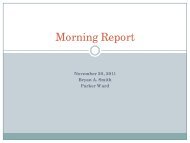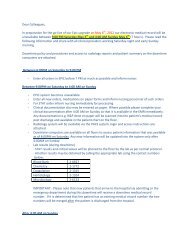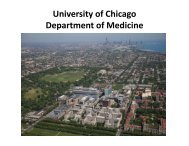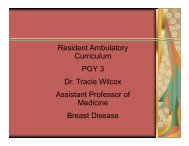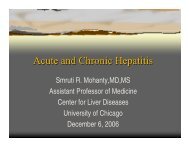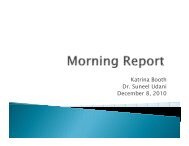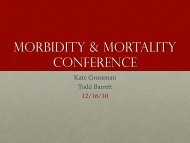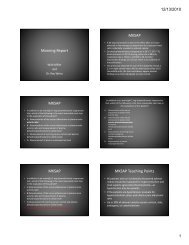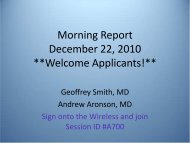Acute management of pulmonary hypertension
Acute management of pulmonary hypertension
Acute management of pulmonary hypertension
You also want an ePaper? Increase the reach of your titles
YUMPU automatically turns print PDFs into web optimized ePapers that Google loves.
<strong>Acute</strong> <strong>management</strong> <strong>of</strong><br />
<strong>pulmonary</strong> <strong>hypertension</strong><br />
Mardi Gomberg-Maitland, MD, MSc<br />
Director, Pulmonary Hypertension<br />
University <strong>of</strong> Chicago
Why all the fuss?<br />
• We DON’T have the luxury <strong>of</strong> TIME<br />
• Small changes in clinical status that<br />
normally you may think are not important,<br />
ARE and these patients CRASH<br />
QUICKLY<br />
• When we miss them, we may be too late!
PAH Classification 2003<br />
• Idiopathic (IPAH)<br />
• Familial (FPAH)<br />
• Pulmonary <strong>hypertension</strong> associated with (APAH)<br />
– Collagen vascular disease<br />
– Congenital systemic to <strong>pulmonary</strong> shunts<br />
– Portal <strong>hypertension</strong><br />
– Drugs/toxins<br />
– HIV infection<br />
• Persistent <strong>pulmonary</strong> <strong>hypertension</strong> <strong>of</strong> the newborn<br />
• PAH with venous/capillary involvement (PVOD, PCH)<br />
Simonneau G et al. J Am Coll Cardiol. 2004;43(12 Suppl 1):5S-12S.<br />
Rich S. Executive Summary from the World Symposium-PPH 1998; World Health Organization.
Non-PAH<br />
• Pulmonary <strong>hypertension</strong> (PH) with left heart disease<br />
– Atrial or ventricular<br />
–Valvular<br />
• PH with lung disease/hypoxemia<br />
– Chronic obstructive <strong>pulmonary</strong> disease (COPD)<br />
– Interstitial lung disease<br />
– Sleep-disordered breathing<br />
– Developmental abnormalities<br />
• PH due to chronic thrombotic and/or embolic disease<br />
Simonneau G et al. J Am Coll Cardiol. 2004;43(12 Suppl 1):5S-12S.<br />
Rich S. Executive Summary from the World Symposium-PPH 1998; World Health Organization.
Vascular Homeostasis<br />
(Balanced Equilibrium)<br />
Stimulators Inhibitors<br />
Smooth<br />
Muscle Cell<br />
Growth Apoptosis<br />
Endothelial<br />
Cell
Imbalance <strong>of</strong> Vascular Growth<br />
Stimulators<br />
Proliferation<br />
in PAH<br />
Smooth<br />
muscle cell<br />
Endothelial<br />
cell<br />
Inhibitors<br />
Apoptosis
Pulmonary Artery Smooth Muscle Cell<br />
(Permissive Genotype)<br />
Phenotypic switch<br />
Hypertensive <strong>pulmonary</strong> artery<br />
Smooth muscle cell<br />
Hypertensive <strong>pulmonary</strong><br />
endothelial cell<br />
Risk factors
Pathology <strong>of</strong> PAH<br />
• Neomuscularization <strong>of</strong> arterioles<br />
• Medial hypertrophy<br />
• Concentric laminar intimal fibrosis
• Thrombin deposition<br />
Pathology <strong>of</strong> PAH
Plexiform Lesions<br />
Endothelial Cell Proliferation<br />
Yeager ME et al. Circ Res. 2001;88:E2-E11. Taraseviciene-Stewart L et al. FASEB J. 2001;15:427-438.
Is There a Reason to Suspect PAH?<br />
Clinical History (Symptoms, Risk Factors), Exam, CXR,<br />
and ECG<br />
• Dyspnea<br />
• Angina<br />
• Syncope<br />
• Edema<br />
• Raynaud’s disease
Definitions<br />
Normal PAP 18-25 / 6-10 mmHg<br />
with mean 12-16 mmHg<br />
Pulmonary <strong>hypertension</strong>= mean >20mmHg<br />
Pulmonary vascular resistance (PVR)<br />
(mean PA-wedge)/CO (normal
World Health<br />
Organization Classification<br />
Class I: No limitations<br />
Class II: Slight limitation <strong>of</strong> physical activity,<br />
ordinary activity causes dyspnea, fatigue,<br />
chest pain, or near syncope<br />
Class III: Marked limitation, less than ordinary<br />
activity<br />
Class IV: Inability to perform activity without<br />
symptoms, signs <strong>of</strong> right heart failure,<br />
dyspnea, and/or fatigue at rest; discomfort<br />
increases with any physical activity<br />
Rich S. Executive Summary from the World Symposium-PPH 1998; World Health Organization.
PAH Prognosis: Functional Class<br />
Correlates With Survival<br />
Class I and Class II: 6 years<br />
Class III: 2.6 years<br />
Class IV: 6 months<br />
Based on NIH registry<br />
D'Alonzo GE et al. Ann Int Med. 1991;115:343-349.
CO<br />
PAP<br />
PVR<br />
PAH: Hemodynamics over Time<br />
Pre-symptomatic/<br />
Compensating<br />
Symptomatic/<br />
Decompensating<br />
Time (variable)<br />
Declining/<br />
Decompensated<br />
Symptom Threshold<br />
R Heart<br />
Failure/Death
Is There a Reason to Suspect PAH?<br />
Clinical History (Symptoms, Risk Factors), Exam, CXR,<br />
and ECG<br />
• Presence <strong>of</strong> PH<br />
– Loud P2 – RV lift<br />
– Systolic murmur (TR)<br />
– Diastolic murmur (PR)<br />
–RV S4 gallop<br />
McGoon M, et at. Chest. 2004;126:14S-34S.<br />
• Presence <strong>of</strong> RV<br />
failure<br />
– JVD with V wave<br />
–RV S3 gallop<br />
– Hepatomegaly<br />
– Edema<br />
– Ascites
Is There a Reason to Suspect PAH?<br />
Clinical History (Symptoms, Risk Factors), Exam,<br />
CXR, and ECG<br />
RV Enlargement<br />
into Retrosternal Clear<br />
Space<br />
Courtesy <strong>of</strong>: Michael McGoon, MD<br />
Peripheral<br />
Hypovascularity<br />
(Pruning)<br />
Prominent Hilar<br />
Pulmonary Arteries
Findings On Electrocardiography<br />
RAD<br />
RAE<br />
RAD, RAE, RVH with strain<br />
RVH RV strain
RV<br />
RA<br />
Echocardiography<br />
LV<br />
LA<br />
RV<br />
LV<br />
Apical 4 chamber Parasternal Short Axis
4 Most Common Causes <strong>Acute</strong> SOB<br />
• Cardiogenic shock/Right heart failure<br />
• Infection<br />
• Arrythmia<br />
• Thromboembolism
Vitals/Physical Exam: Important<br />
• May be in cardiogenic shock with warm extremities<br />
(NOT cold and clammy)!<br />
• Signals for low cardiac output:<br />
- change in mentation<br />
- syncope<br />
- drop in urine output<br />
- drop in oxygen saturation (pulse ox)<br />
- relative drop in blood pressure<br />
- nausea/emesis, abdominal pain
The Downward Spiral<br />
HYPOTENSION RVEDP<br />
REDUCED RV CORONARY BLOOD FLOW<br />
RV ISCHEMIA<br />
CARDIAC OUTPUT
Hemodynamic and biochemical correlates <strong>of</strong><br />
RV failure from <strong>pulmonary</strong> <strong>hypertension</strong><br />
Coronary<br />
driving<br />
pressure<br />
(mmHg)<br />
Lactate/<br />
pyruvate<br />
Control<br />
65<br />
17.6<br />
Vlahakes G, et al. Circulation 1981;63:87<br />
RV<br />
<strong>hypertension</strong><br />
44<br />
13.9<br />
Failure<br />
23<br />
56.8<br />
Phenylephrine<br />
78<br />
19.5
<strong>Acute</strong> Management<br />
Low Output:<br />
- drop in blood pressure: inotropes: low dose<br />
dopamine, phenylephrine (less tachycardia)goal<br />
systemic vasoconstriction<br />
**goal SBP higher than with left heart disease<br />
>100 mmHG**<br />
- fluid bolus not routine especially if left heart<br />
disease as this can cause PULMONARY<br />
EDEMA
<strong>Acute</strong> Management<br />
Anasarca:<br />
High dose diuretics: lasix drips at<br />
high rates with metolazone<br />
**OK to lose 5-6 L net/day (if BP low<br />
in this setting will use inotropes with lasix<br />
drip)
Infection<br />
Hypotension, tachycardia, fever all are not<br />
well tolerated<br />
Need to culture and start antibiotics<br />
sometimes empirically, and may need<br />
inotropes<br />
THESE PATIENTS HAVE NO RESERVE!
Atrial Arrhythmia<br />
Retrograde P waves
Treatment <strong>of</strong> Atrial Arrhythmias<br />
Routine treatment is calcium channel<br />
blocker or beta blocker IV but if<br />
suspect PAH do echocardiography<br />
first because these drugs can cause<br />
acute cardiogenic shock in PAH!
Atrial Arrhythmia<br />
Despite the presence <strong>of</strong> right atrial<br />
enlargement, most commonly atrial<br />
arrhythmias present in late disease unless<br />
if secondary to congenital heart disease<br />
(especially post repair).<br />
<strong>Acute</strong> Treatment: IV amiodarone,<br />
IV digoxin, IV d<strong>of</strong>etilide,<br />
DC cardioversion
Chronic Treatment:<br />
Atrial Arrhythmia<br />
Medical: oral amiodarone, oral d<strong>of</strong>etilide,<br />
? Sotalol<br />
Electrophysiology procedures:<br />
1. Ablation: flutter, atrial tachycardia, AVNRT,<br />
accessory pathways, atrial fibrillation<br />
2. PPM with AV nodal ablation<br />
3. Atrial remodeling
Main Points : Atrial Arrhythmia<br />
• Aggressive treatment needed as<br />
arrhythmia is not well tolerated in PAH<br />
• ECHO acutely if unsure if PAH<br />
• <strong>Acute</strong> treatment with amiodarone,<br />
digoxin, d<strong>of</strong>etilide,DC cardioversion<br />
• Chronic treatment with medication/EP<br />
procedures
• Patients have high vagal tone therefore<br />
pain control is important<br />
• Use atropine<br />
Bradycardia
Ventilation Perfusion Lung Scan<br />
Primary<br />
Pulmonary<br />
Hypertension<br />
Chronic<br />
Pulmonary<br />
Embolism
CT Scan
Mosaic Perfusion
Pulmonary Arterial Hypertension (PAH):<br />
Therapy<br />
• General measures<br />
– Diuretics, oxygen<br />
– Digoxin<br />
• Anticoagulants (ACs) (evidence ±)<br />
• Vasodilators/antiproliferative<br />
– Calcium channel blockers (CCBs)<br />
– Prostacyclins<br />
– Endothelin receptor antagonists (ERAs)<br />
– Phosphodiesterase 5 (PDE 5) inhibitors<br />
– Investigational agents<br />
• Atrial septostomy<br />
• Lung transplant
Digoxin<br />
Oxygen<br />
General Treatment Options<br />
• May increase contractility in right heart<br />
failure<br />
• May reduce sympathetic activation<br />
• Symptomatic relief<br />
• Maintain O2 saturation ≥91% if<br />
desaturation is present at rest, sleep, or<br />
with ambulation
Diuretics<br />
General Treatment Options<br />
• Reduce peripheral edema, intravascular<br />
volume, and venous pressure<br />
• Avoid excessive diuresis<br />
• Monitor electrolyte balance<br />
• Combination <strong>of</strong> loop diuretic and<br />
metolazone or spironolactone may be<br />
beneficial
Digoxin and Oxygen<br />
• If renal failure remember digoxin<br />
toxicity<br />
• Oxygen- symptomatic relief<br />
Maintain saturation>91% at rest, with<br />
exercise, with sleep, in the hospital
Anticoagulation<br />
• Recommended for patients with PAH<br />
• May prolong survival by preventing thrombin<br />
induced vascular proliferation<br />
• not likely to affect symptoms<br />
• Suggested INR 2.0-3.0<br />
• *THEREFORE OK TO STOP AS THIS IS<br />
CHRONIC THERAPY- prefer Vitamin K to FFP<br />
due to volume load
%<br />
Survival<br />
Rich S et al. N Engl J Med.<br />
1992;327:76-81.<br />
Effect <strong>of</strong> High-Dose CCBs on<br />
100<br />
90<br />
80<br />
70<br />
60<br />
50<br />
40<br />
Survival in PPH<br />
Months<br />
0 12 24 36 48 60<br />
Responders<br />
Nonresponders<br />
NIH Registry Cohort<br />
NIH Registry Patients<br />
treated at UIC
Calcium Channel Blockers<br />
• If responders, these patients are on<br />
higher doses than you are used toamlodipine<br />
10 mg twice daily,<br />
diltiazem 360 mg twice daily<br />
• Don’t worry that this will drop their<br />
blood pressure- give the medication<br />
pre procedure.
Epoprostenol (Flolan)<br />
*short half life- no more than 6 minutes!<br />
*can’t switch lines without priming with<br />
epoprostenol<br />
*medication needs to be kept cold- ice<br />
packs frozen solid- MAKE SURE<br />
CHANGE ICE PACKS q6-8 HOURS
Cumulative Survival<br />
1<br />
0.8<br />
0.6<br />
0.4<br />
0.2<br />
0<br />
Long-Term Outcome in IPAH With<br />
Months<br />
Sitbon O, et al. J Am Coll Cardiol. 2002;40:780-788.<br />
Epoprostenol<br />
IV epoprostenol<br />
(n=178)<br />
p
Required Supplies for<br />
Epoprostenol Administration<br />
• Supply <strong>of</strong> epoprostenol<br />
• Glycine Buffer Diluent<br />
• Portable Infusion Pump (2)<br />
• Medication cassettes 50 or 100ml<br />
• IV extension sets with 0.22 micron<br />
filter to connect to subclavian<br />
catheter<br />
• Insulated carrying pouch<br />
• Cold Packs<br />
• 9 volt batteries for pumps<br />
• Normal Saline for injection<br />
• Antimicrobial Soap<br />
• Povidone-Iodine Solution<br />
• 70% Alcohol<br />
• Dressing Change Kits<br />
• Betadine prep pads<br />
• Alcohol Prep pads<br />
• Needles (18 and 23 gauge)<br />
• Syringes (3ml, 10ml, 60ml Luer<br />
Lok®)<br />
• Other, as needed
*patients know more than all <strong>of</strong> us! LEARN from them<br />
*cassette changes need to be ON TIME! Efficacy decreases<br />
past 24 hours- in hospital 24 hour cassette always not 8<br />
hour option<br />
*change tubing every 3 days<br />
Epoprostenol:<br />
*need to go through a stable line if Hickman catheter is not<br />
working- PICC line/central line<br />
*CADD pump- any questions call PH TEAM
Prostacyclin Problems:<br />
Leaking Hickman<br />
Need to have stable line to for flolan/remodulin<br />
and then can repair catheter!<br />
Place central access and CALL PH TEAM to<br />
prime line
Treprostinil Sodium Injection<br />
Usage/Administration/Delivery System<br />
• Administered via<br />
continuous infusion using<br />
an ambulatory pump<br />
designed for<br />
subcutaneous infusions<br />
• Administered via a selfinserted<br />
subcutaneous<br />
catheter
Treprostinil (Remodulin)<br />
*longer half life- 4.6 hours- larger<br />
*medication stable at room temperature- no ice<br />
packs<br />
*now IV therapy available- half life 4.4 hours<br />
*change medication q 48hrs
Inhaled Iloprost<br />
• Approved by FDA in December 2004 for class III,<br />
IV PAH<br />
• Duration <strong>of</strong> hemodynamic effect only 90 minutes<br />
• Requires frequent administration; at least 6x/day<br />
at 10 to 15 minutes<br />
• Trials in Europe: Improved FC, 6MW, Hemodynamics<br />
vs. placebo<br />
• Has favorable effects on gas exchange in <strong>pulmonary</strong><br />
fibrosis<br />
• Patient will bring device to ER<br />
Olschewski H, et al. N Engl J Med. 2002;347:322-329.
• Oral<br />
Endothelin Antagonists (ERAs)<br />
• “Nonselective” ERA/ERB<br />
• Bosentan*<br />
• “Selective” ERA<br />
• Sitaxsentan †<br />
• Ambrisentan †<br />
*FDA approved<br />
† Investigational/in development
ERAs<br />
• Patients are to take their own bosentan<br />
(Tracleer). First month 62.5 twice daily<br />
then uptitrated to 125mg twice daily. It is<br />
available at U <strong>of</strong> C pharmacy if needed<br />
• If patients have liver failure, medication is<br />
discontinued.<br />
• No known rebound if miss dose.
L-Arginine<br />
Potential <strong>of</strong> PDE-5 Inhibitors<br />
as a Treatment for PAH<br />
• PDE-5 located in <strong>pulmonary</strong> circulation<br />
• PDE-5 responsible for cGMP hydrolysis in the lung<br />
• cGMP appears to regulate <strong>pulmonary</strong> vascular tone and growth<br />
• PDE-5 inhibitor raises cGMP levels<br />
eNOS<br />
Nitric<br />
oxide<br />
PDE-5I<br />
Wharton J et al. Am J Respir Crit Care Med. 2005;172:105-113.<br />
cGMP Lowers<br />
PA<br />
PDE-5 pressure<br />
GMP
PDE-5 Inhibitors<br />
• These patients are on higher doses than<br />
you are used to- sildenafil 80 mg three<br />
times daily<br />
• May drop blood pressure, call us if<br />
hypotensive before holding- but like<br />
calcium blockers if on chronic therapy<br />
unlikely acute drop if all else stable<br />
• May be rebound effect- don’t hold
PH Cardinal Rules<br />
1. PH PATIENTS HAVE LITTLE<br />
CARDIOVASCULAR RESERVE<br />
2. CALL US! There are no unimportant<br />
questions!<br />
3. CALL US! There are no unimportant<br />
questions!


